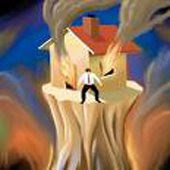 Mlive.com has an interesting article about a prescribed fire in Montcalm County conducted by the Michigan Department of Natural Resources. Here is an excerpt:
Mlive.com has an interesting article about a prescribed fire in Montcalm County conducted by the Michigan Department of Natural Resources. Here is an excerpt:
A wall of flames swept across dried grasslands in southern Montcalm County on a recent weekday, sending skyward a column of smoke visible for several miles.
Winds from the northwest fanned the April 29 blaze, which charred 60 acres in the Flat River State Game Area before dying out.
There were no evacuations or live TV coverage like we saw April 25-26 when an 1,100-acre forest fire near Grayling forced the closing of part of Int. 75. The cause of the Grayling fire remains undetermined.
Not so with the Greenville-area fire. Guys dressed in yellow suits started this fire with a mix of diesel fuel and unleaded gasoline and a handy propane lighter. This particular fire was a controlled burn, staged by the state Department of Natural Resources with assistance from certified firefighters.
It is not unlike what’s taking place now in Texas, Virginia, Colorado and Wisconsin. The U.S. Fish and Wildlife Service this year will use fire to improve wildlife habitat on more than 400,000 acres.
Anyone interested in creating better habitat for legions of endangered plants, insects and animals should be grateful for such burns. Like a good soaking spring rain, fire has a way of bringing new life to tired land.
The fire near Greenville targeted a tiny pocket of the 10,000-acre Flat River State Game Area, but long-term benefits extend beyond the still-blackened earth. Once used for farming, the land has been overrun with invasive plants, such as spotted knapweed, autumn olive and Chinese elm.“We’re trying to convert it to oak Savannah,” said Steve Cross, a DNR fire management specialist based in Cadillac who served as fire boss this day. “Fire is an important tool to get us there.”
Are you a deer or turkey hunter? Perhaps a butterfly fanatic? Or is your passion Michigan native wildflowers? If you value any of the above, then you should be fired up about fire.
They all live within the oak savannas of southwest Michigan. The land is sandy and dry and tree growth sparse. What does thrive, however, are native grasses and wildflowers, including little blue stem, coreopsis and wild lupine.
Photos courtesty of Mlive.com





